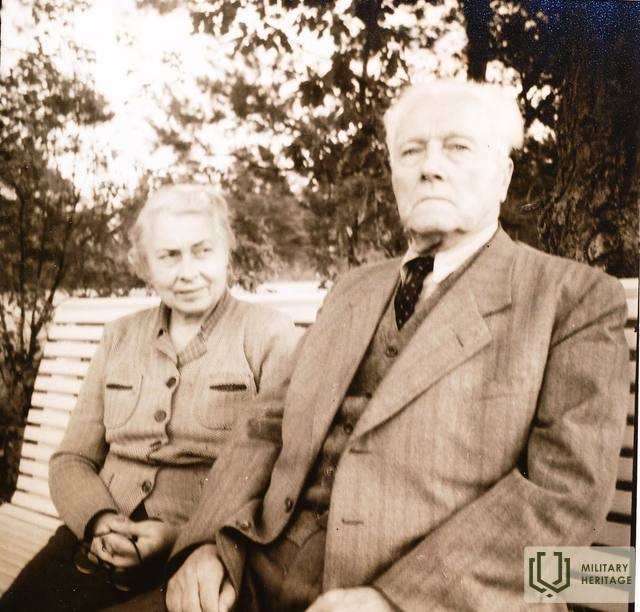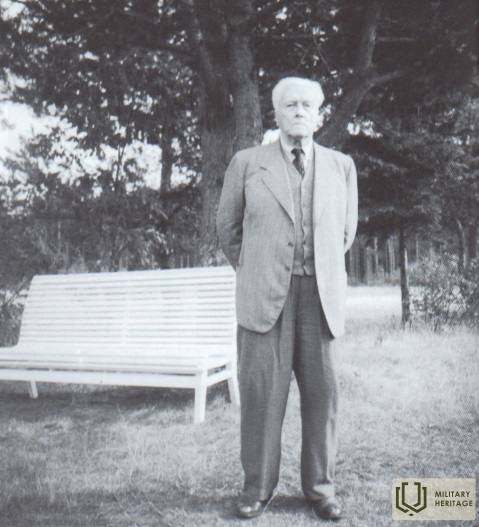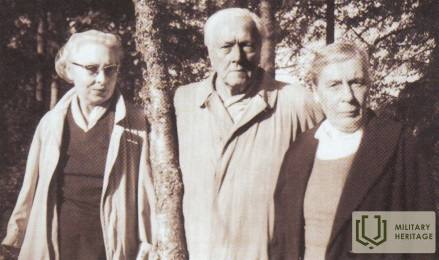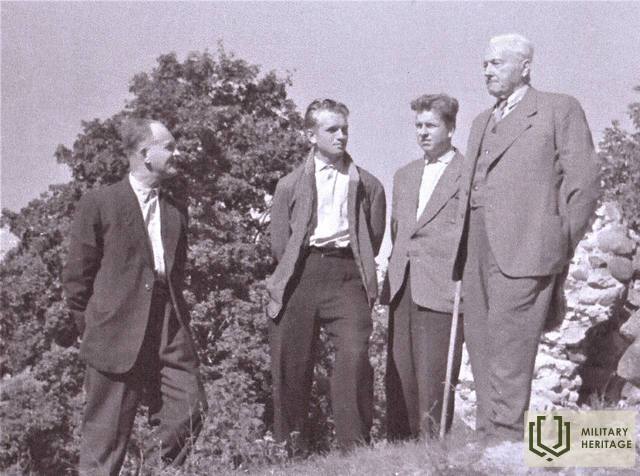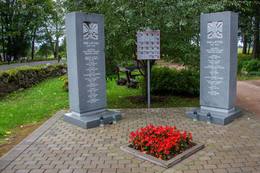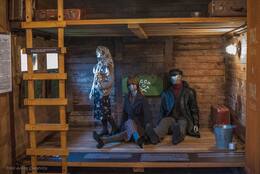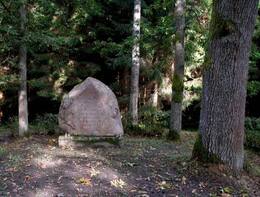The life of General Jānis Baložs after his return from exile
When in 1940 the Russians tried to squeeze a favorable military base agreement from the Latvian government, which would make the Latvian army's ability to resist the Red Army almost impossible, General J. Balodis tried to get some amendments to the agreement. However, this did not work. But the general's detractors used this circumstance to later make J. Balodis almost a traitor. After a conflict with the Prime Minister and State Minister K. Ulmanis, the general was dismissed from the post of Minister of War on April 5, 1940. Then J. Balodis decided to participate in the Saeima elections from the Democratic Bloc, but nothing came of it, because only one list was allowed to run in the elections - the list of communist candidates. Latvia became the 14th Soviet republic.
On July 31, 1940, the acting Prime Minister Vilis Lācis personally wrote an order to expel the former Latvian Minister of War, General J. Baložs, and her family from the Latvian Soviet Socialist Republic. On the same day, the general and his wife were arrested and taken to Syzran in Russia. Until 1952, both spouses were in various Russian prisons. Only in 1952 did the “comedy” of a trial take place, without the defendants even participating in it, in which both J. Balodis and his wife Elvīra Balodi were sentenced to 25 years in prison for “treason to the homeland”. In 1954, after 13.5 years in prison, J. Balodis and E. Balodis were amnestied, but they had to remain in Vladimir. After that, both Elvīra and Jānis illegally enter Latvia several times, but they are arrested again and sent back to Vladimir in stages. Only in the spring of 1960, after 11 requests submitted to the Soviet government in Moscow, are both Baložs allowed to return to Latvia legally. They manage to register with Baložs' cousin, Mrs. Ozola, in Riga, in the former Sinka house on Tērbatas Street. Both have to live on only an 80-ruble pension.
J. Balodis and his wife spent their summers in Saulkrasti from 1959 to 1965, and for the last four years they rented half of a small summer house in a beautiful, picturesque place, on the edge of the forest near the Ķīšupīte tributary Pupaļurga, now Krasta Street 10. Currently, asphalted streets and rows of houses stretch here, but at that time meadows spread around the house and cows and sheep grazed in them. This summer house was built in 1960 and belonged to Maksim and Marta Šibas. The owners lived on the 2nd floor with their son and mother-in-law, while General J. Balodis with his wife Elvira and the farm manager Marija, who was also considered a family member, rested on the 1st floor. They have a living room and a bedroom here.
Not everyone at that time was brave enough to take in those who had returned from exile, let alone a general! General Jānis Francis, who lived at 4 Alfrēda Kalniņa Street in Saulkrasti at the time, helped General Balodis find a summer residence. Former Foreign Minister Munters and his wife were frequent guests at Balodis in Saulkrasti.
From Marta Šibasė's memoirs in the newspaper "Mājas Viesis" we learn that Mrs. Baloža Elvīra loved flowers, she planted them around the house and tended them. The Baložas also liked to pick mushrooms, they would pick boletus, buttercups and birch leaves in the pine forest. They made a delicious mushroom soup, which Mrs. Baloža especially liked.
While relaxing in Saulkrasti, the general listens to the radio a lot, especially the evening news. The two also read a book together: the husband reads aloud, while the wife turns the pages.
In the summers of 1961 and 1962, the general, together with his friends, visited his native Trikāta, went on excursions along the banks of the Venta and Daugava rivers, visited Staburagi and the memorial site of General O. Kalpaks "Airītes". He also went on a several-day trip to Vilnius and Trakai in Lithuania.
On March 8, 1963, J. Balodis had an accident. Living in Riga, he went to a kiosk in the morning to get a newspaper. He fell on a slippery street and broke his leg. Treatment in the hospital lasted until mid-July. The general also began to have health problems with his liver at this time. During his illness, he very much missed Saulkrasti, where he could warm up in the sun and relax. He only managed to do this in the second half of the summer.
J. Balodis died on August 8, 1965 in Saulkrasti, was removed from the house at 10 Krasta Street and buried in the II Meža Cemetery.
Despite the Soviet authorities' attempts to suppress information about Baložs' funeral, several thousand people surrounded the White General during his final rites.
Article "General Jānis Balodis turns 135 this year", author: Dagnija Gurtiņa, 09.02.2016 Saulkrasti City Council News
Related topics
Related objects
Memorial sites of generals and knights of the Lāčplēsis Military Order in Trikāta parish
The memorial stele is located next to the Trikāta cemetery chapel.
The Trikāta cemetery preserves the memory of three outstanding Latvian generals - Roberts Dambītis, Kārlis Goppers and Jānis Balodis. The teacher of all these generals, Jēkabs Mūrnieks, is also buried in the Trikāta cemetery, for whom a monument made of travertine, modeled after Kārlis Zāle, was erected at the burial site in 1928.
The generals and knights of the Lāčplēsis Military Order are commemorated every year with torchlight processions to the Trikāta cemetery, where there are two memorial steles, in which a total of 17 names of knights of the Lāčplēsis Military Order associated with the Trikāta parish are engraved.
The stele was unveiled on November 11, 2018.
Video about the Lāčplēsis War Order and a set of orders that belonged to General Jānis Balodis.
Cattle wagon used for deportations – museum at Skrunda train station
To commemorate the deportations of June 1941 and March 1949, a memorial stone and a four-axle wagon, which also serves as the museum dedicated to deportations, was erected at the Skrunda railway station. This is the first wagon-type museum in Latvia that holds a permanent exhibit of photos, letters, memoirs, documents and various items made by the people deported from the Skrunda station. Skrunda station was a location where deportees were gathered, and one of the three stations in the region to which people from the Skrunda and the Kuldīga area were brought. In 1941, the family of the first President of the restored Republic of Latvia, Guntis Ulmanis, was deported from here to Krasnoyarsk Krai in Siberia.
With the help of deportations, the Soviets dealt with supporters of the national partizans’ and at the same time intimidated the remaining rural population, forcing them to join the collective farms.
Memorial stone at the battle site of General Jānis Baložs' brigade
The memorial stone at the site of the battle of General Jānis Baložs' brigade is located in the forest near the Riga - Liepāja (A9) highway, near the Batari house.
The memorial stone was unveiled in 1936 with a solemn ceremony attended by the then Minister of Transport B. Einbergs and other high-ranking Riga officials and the public of Džūkste parish, commemorating the battle that took place here on March 22, 1919. The inscription engraved on the monument reads: “Here, on March 22, 1919, the battle of the 1st Separate Baloži Brigade took place, in which 10 soldiers fell and 28 were wounded.”
The battle took place between the Separate Latvian Brigade and the 10th Soviet Latvian Rifle Regiment, which consisted of 90 percent Latvians. During the freedom struggle, it was one of those battles in which Latvians fought against Latvians. The Bolsheviks had established themselves in the Batari houses. They began to fire on the brigade soldiers who were heading in the direction of Kalnciems. As the fire intensified, the brigade deployed for battle. The main burden of the battle was borne by the Separate Student Company and the Latvian Independence Battalion. As the battle dragged on, a platoon of the student company and the newly formed company of Captain E. Graudiņš, while performing a bypass maneuver, collided in the forest with the enemy, who was performing a similar maneuver. In a fierce battle, which in some places turned into close combat, the enemy was defeated. At this time, the German Miller battery assigned to the brigade opened fire on the Batari houses. After artillery fire, the brigade drove the enemy from his positions in a swift attack.
The newspaper “Brīvā Zeme” (18.05. 1936) published the memories of a former fighter: “The brigade’s cavalry had just ridden out into the open, when they were met by heavy enemy fire. After that, it was clear that they were dealing with very strong enemy forces. The battalions, on the orders of General J. Baložs, deployed and began to fight, getting into close combat, as the bayonets of the brigade’s soldiers decided this two-hour battle into a brilliant victory for the Kalpakians. This battle was of great importance, because it leveled the situation on the front, which had become unsafe because of the Germans, and ensured that the Red Riflemen’s regiments no longer entered the Zemgale Plain.”
General J. Baložs' brigade won the battle, losing 10 soldiers, including Kārlis Barons (1900.8.III – 1919.22.III), the grandson of the father of the Dainas, Krišjānis Barons, who is buried in the Riga Brothers' Cemetery. 50 soldiers of the Soviet Latvian Riflemen Regiment fell in the battle.




